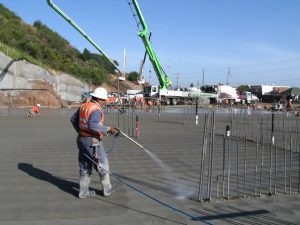Curing :
Fresh concrete gains strength most rapidly during the first few days due to hydration of cement which can take place only in the presence of water. Design of reinforced concrete structures is based on the 28 days strength of 15 cm cubes about 70% of which is attained at the end of the first week after placing. The final strength of concrete depends greatly on the conditions of moisture and temperature during this initial period. The maintenance of proper conditions during this period is known as curing.

About 30% of the strength can be lost by premature drying out of the concrete and similar amount may be lost by permitting concrete to drop to 2°C or lower during the first few days. To prevent such damage, concrete should be protected from loss of moisture for at least 7 days. Curing can be done in several ways such as:
(1) Moist curing which consists of the application of water directly to the concrete or by means of continuously saturated coverings of sand, straw or hessian etc.
(2) Surface application of calcium chloride which not only absorbs moisture from the atmosphere but also prevents the evaporation of a part of the mixing water.
(3) Membrane curing in which certain chemical compounds are applied to all exposed surfaces of concrete to form an impervious film on the concrete which prevents the evaporation of moisture,
(4) The chemical reaction of hydration of cement can be accelerated under increased temperature which can be achieved by resorting to steam curing at atmospheric pressure. An efficient steam curing cycle depends on the pre-curing period, the rate of increase and decrease of temperature. The object of steam curing is to develop high early strength of concrete so that concrete products may be removed from the form work and handled as early as possible. It is mainly used in precast or prestressed concrete works.





